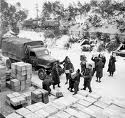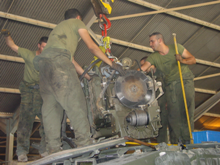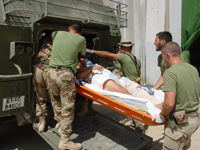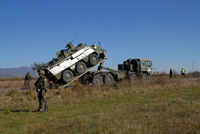- Home
- UNITS
- A Coruña
- Texto no traducido
- Background
- Texto no traducido
MENÚ UNIDAD
ARMY UNITS
- Araba Álava |
- Albacete |
- Alicante |
- Almería |
- Asturias |
- Ávila |
- Badajoz |
- Barcelona |
- Burgos |
- Cáceres |
- Cádiz |
- Cantabria |
- Castellón |
- Ceuta |
- Ciudad Real |
- Córdoba |
- A Coruña |
- Cuenca |
- Girona |
- Granada |
- Guadalajara |
- Gipuzkoa |
- Huelva |
- Huesca |
- Islas Baleares |
- Jaén |
- León |
- Lleida |
- Lugo |
- Madrid |
- Málaga |
- Melilla |
- Murcia |
- Navarra |
- Ourense |
- Palencia |
- Las Palmas |
- Pontevedra |
- La Rioja |
- Salamanca |
- Segovia |
- Sevilla |
- Soria |
- Tarragona |
- Santa Cruz de Tenerife |
- Teruel |
- Toledo |
- Valencia |
- Valladolid |
- Bizkaia |
- Zamora |
- Zaragoza

Background
- pagination
-
HISTORICAL EVENTS
BACKGROUND
 Although the Operational Logistic Force is a recent organization, being founded in the year 2005, its origins and needs date back to the eighties when the former regional logistics for specific services was discarded and the organization of a functional, deployment logistics commenced. In time it supported the units in the barracks and allowed for the creation of logistical formations required by any operation wherever sited. This approach is a direct result of abandoning our secular isolation and opening up to foreign policy and our incorporation in international organizations such as NATO in the military field and in the Common Market on a political plane.
Although the Operational Logistic Force is a recent organization, being founded in the year 2005, its origins and needs date back to the eighties when the former regional logistics for specific services was discarded and the organization of a functional, deployment logistics commenced. In time it supported the units in the barracks and allowed for the creation of logistical formations required by any operation wherever sited. This approach is a direct result of abandoning our secular isolation and opening up to foreign policy and our incorporation in international organizations such as NATO in the military field and in the Common Market on a political plane.In this way, the Ministerial Order 142/82 established a formal and functional structure for the Army in order to improve the efficiency of the Force.
Thereafter the Royal Decree 1/1987 established that the Army would be set up as the Headquarters and the Force and Support to the Force, where the Command of Logistic Support as a higher echelon in the execution and direction of logistic activities is found.
 Three Commands of Interregional Logistic Support (MALZIR) were created as intermediate echelons: Northern, central, and southern. As echelons of executions, the Logistics Support Groupings were created In the year 1992, as a result of the generalised participation of the Army in international missions, the Command of Logistic Support to Operations of the Manoeuvre Force was created with the task of providing logistic support from within national territory as deemed necessary for the force deployed overseas.
Three Commands of Interregional Logistic Support (MALZIR) were created as intermediate echelons: Northern, central, and southern. As echelons of executions, the Logistics Support Groupings were created In the year 1992, as a result of the generalised participation of the Army in international missions, the Command of Logistic Support to Operations of the Manoeuvre Force was created with the task of providing logistic support from within national territory as deemed necessary for the force deployed overseas.Prior to the disappearance on the regional organization in the Army, the Royal Decree1132/97 restructured in a military sense the national territory creating Regional Commands (Centre, south, Pyrenees, North-west and the Balearic and Canary Islands, Ceuta and Melilla.
 The Ministerial Order 220/97 introduced the structure of the Army, establishing in each Regional Command and in each area, excluding Ceuta and Melilla which formed part of the MALRESUR, a Command of Logistic Support (MALRE) as an intermediate echelon of logistics, with the powers and responsibility for specific groups of Army units as well as the Logistic Support Command for operations (MALOG.OP). The Logistic Support Groupings and Units and the Command Headquarters of Works were the organisms which carried this out on national territory and in overseas missions it was carried out by the Elements of National Support (NSE,s).
The Ministerial Order 220/97 introduced the structure of the Army, establishing in each Regional Command and in each area, excluding Ceuta and Melilla which formed part of the MALRESUR, a Command of Logistic Support (MALRE) as an intermediate echelon of logistics, with the powers and responsibility for specific groups of Army units as well as the Logistic Support Command for operations (MALOG.OP). The Logistic Support Groupings and Units and the Command Headquarters of Works were the organisms which carried this out on national territory and in overseas missions it was carried out by the Elements of National Support (NSE,s).CREATION OF THE OPERATIONAL LOGISTIC FORCE
 The creation of the Operational Logistic Force was born out of the Ministerial Order Def/3537/2003, on 10th December 2003, and was published in the BOD. 249 on 23rd of December 2003. It determines the basic organizational structure of the Armies.
The creation of the Operational Logistic Force was born out of the Ministerial Order Def/3537/2003, on 10th December 2003, and was published in the BOD. 249 on 23rd of December 2003. It determines the basic organizational structure of the Armies.This regulation establishes that the Operational Logistic Force is to be formed by all the Army units whose main task is to be prepared to provide, within the Force’s field of action, the necessary logistic support for combat operations as well as operational logistic support missions of the host nation.
Additionally, the FLO’s task is to provide permanent support to the Army Units. The instruction 57/2005 regarding the Organizational and Operational norms of the Army indicates in article 119, that:
 The Operational Logistic Force is the group of Army units whose main task is to be prepared to provide, within its scope of action, the necessary logistic support for combat operations and missions of operational logistic support of the host nation and within its sphere, to provide permanent support to all the units so as to maintain all the units, Centres and Organisations of the Army operational, including those units which operate outside the national territory.
The Operational Logistic Force is the group of Army units whose main task is to be prepared to provide, within its scope of action, the necessary logistic support for combat operations and missions of operational logistic support of the host nation and within its sphere, to provide permanent support to all the units so as to maintain all the units, Centres and Organisations of the Army operational, including those units which operate outside the national territory.In order to adapt to the new dimensions and structure of the Army, the technical evolution and equipment and the requirements of operations, a re-organization took place under the Royal Decree 416/2006 whereby a more reduced organization of the Operational Logistic Force was established. This allows for capabilities to be maximised using the same resources and to overcome the existing fragmentation.



